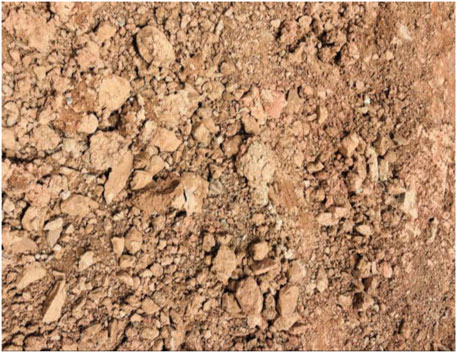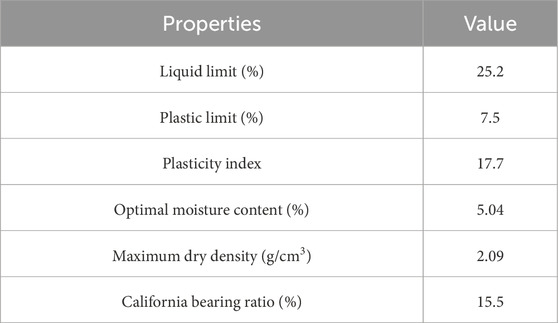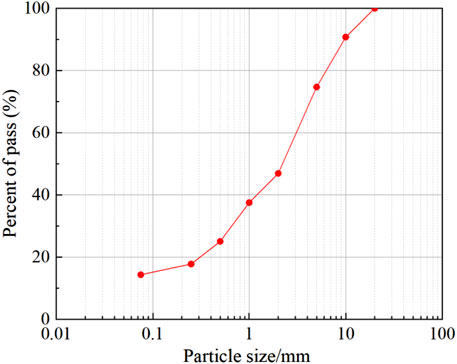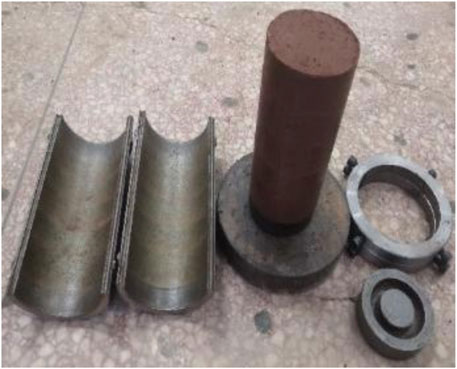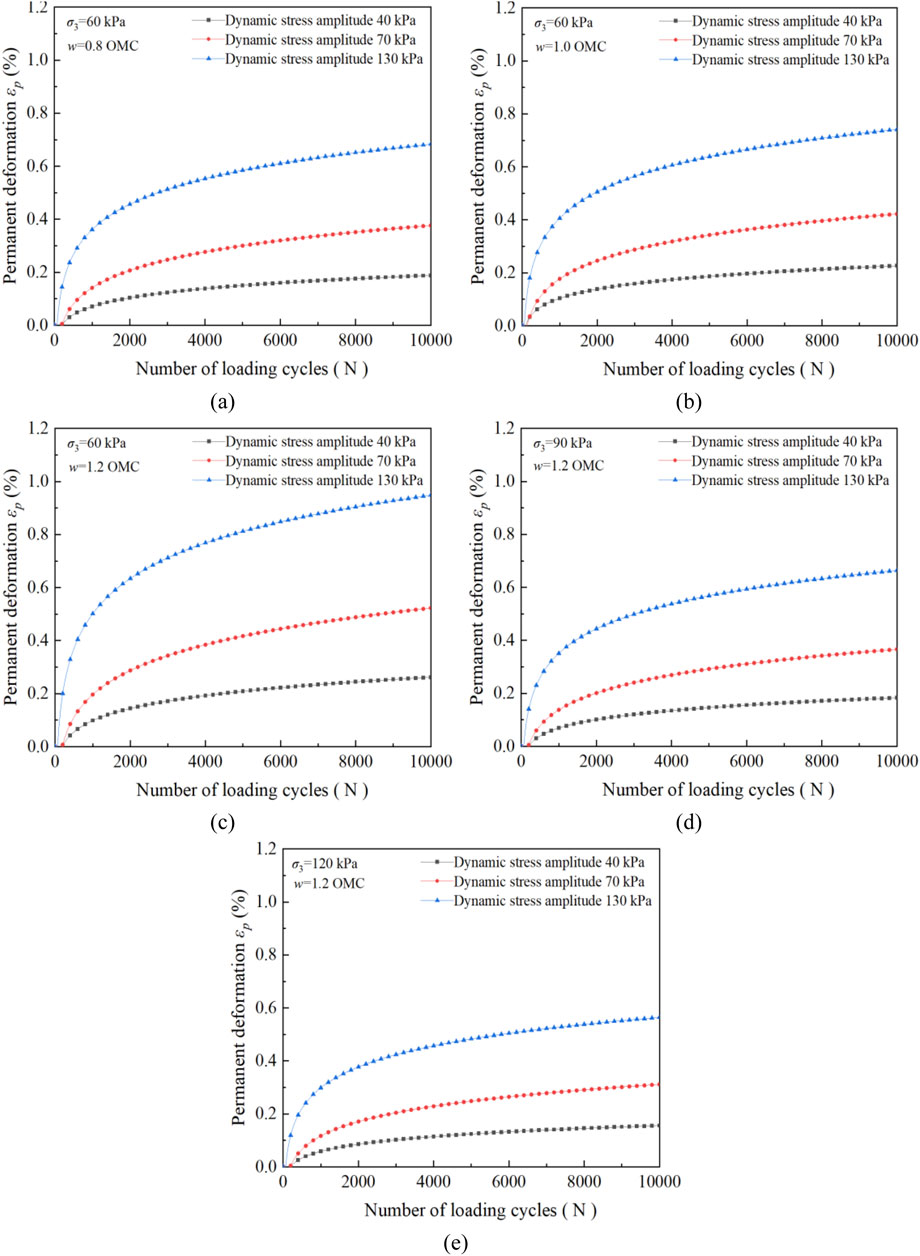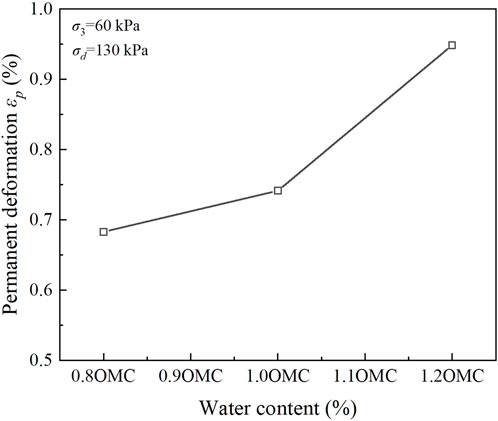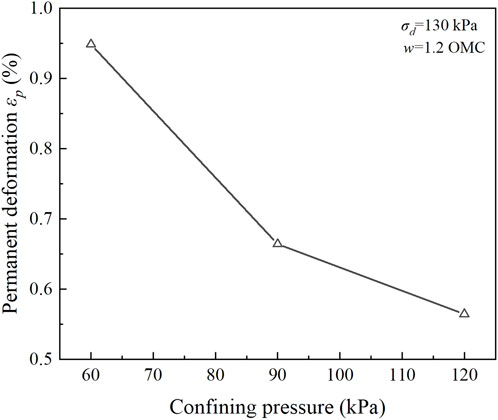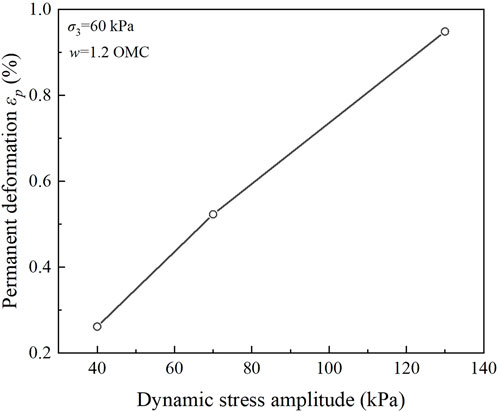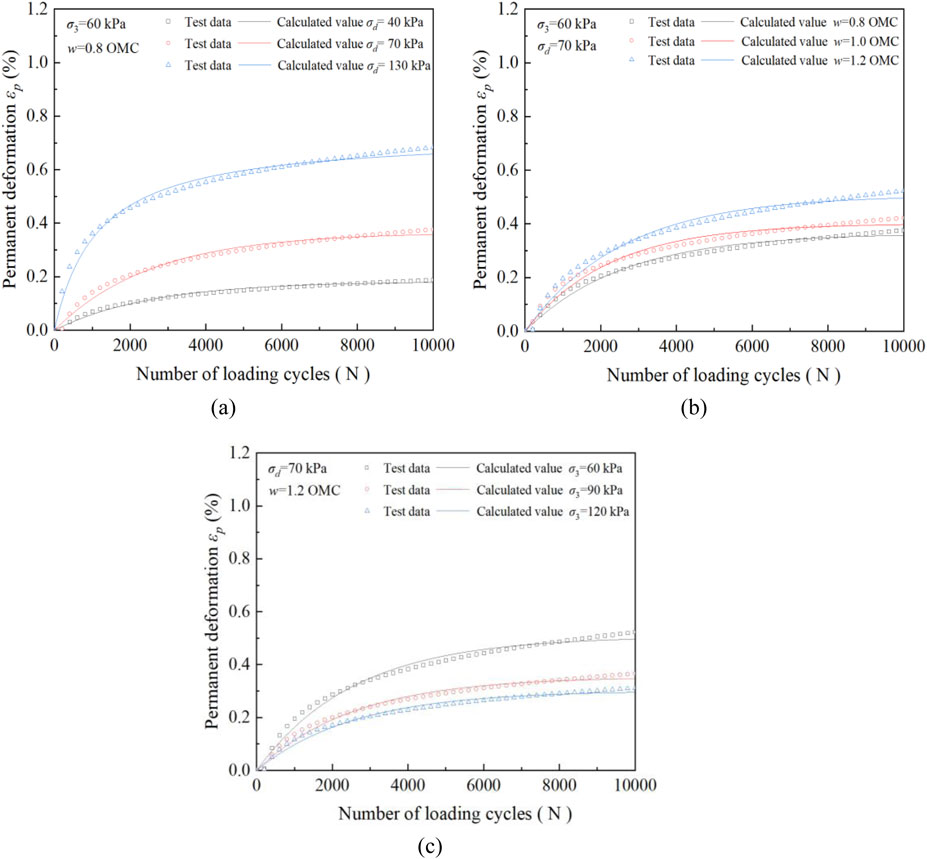- 1Zhejiang Communications Investment Group Expressway Construction and Management Co., Ltd., Hangzhou, Zhejiang, China
- 2School of Transportation, Changsha University of Science & Technology, Changsha, China
The permanent deformation characteristics of subgrade filler under cyclic loading are the key factors affecting the long-term stability of subgrade and pavement performance. This study aims to systematically analyze the permanent deformation characteristics of construction waste soil as subgrade filler under cyclic loading through dynamic triaxial tests to optimize roadbed design and extend its service life. Results indicate that confining pressure, moisture content, and dynamic stress amplitude significantly affect permanent deformation. Specifically, increasing confining pressure from 60 kPa to 120 kPa reduces permanent deformation by 40%, while increasing moisture content from 0.8 to 1.2 times the optimum moisture content increases deformation by 36%. The dynamic stress amplitude is increased from 40 kPa to 130 kPa, and the deformation is increased by 263%. Based on the experimental data, the prediction model of permanent deformation of subgrade filler is established, and the prediction accuracy and universality of the model are verified by comparing with the experimental data of this study and other existing literature. The model can provide a scientific basis for subgrade design and help to select construction parameters reasonably, so as to effectively control the permanent deformation of subgrade and reduce maintenance costs.
1 Introduction
With the rapid development of transportation, the construction scale of highway and railway is expanding. As an important part of transportation infrastructure, the stability and durability of subgrade have a crucial impact on traffic safety and operation efficiency (Xu et al., 2024; Sun et al., 2025). The subgrade is subjected to the repeated action of vehicle load for a long time in the operation process. This cyclic load will lead to permanent deformation of the subgrade fillers, which will affect the overall performance of the subgrade (Xie et al., 2023; Yang et al., 2025; Wang et al., 2025). Construction waste soil has attracted wide attention as a potential subgrade filler. The construction waste soil usually comes from projects such as building demolition, infrastructure construction and land development, and its production is increasing with the acceleration of urbanization. The use of construction waste soil as subgrade filler can not only reduce the exploitation of natural earth-rock materials and reduce engineering costs, but also reduce the impact of slag stacking on the environment, which has significant economic and environmental benefits (Gu et al., 2023; Xie et al., 2024; Barisoglu et al., 2025). It promotes the resource utilization and sustainable development of construction waste soil.
Under cyclic loading, the deformation of subgrade fillers can be divided into recoverable elastic deformation and irreversible permanent deformation. The permanent deformation will accumulate with the repeated action of cyclic load, and its evolution law is affected by many factors such as stress level, physical state of filler and load characteristics (Hegde and Palsule, 2020; Sun et al., 2023; Zhai et al., 2025). Accurately predicting and controlling the permanent deformation of subgrade fillers under cyclic loading is of great significance for ensuring the long-term stability and service life of subgrade. At present, the research on the permanent deformation of subgrade fillers mainly focuses on the exploration of deformation law and the establishment of prediction model. The established permanent deformation model is generally divided into two categories. The first type is a constitutive model based on the principle of classical soil mechanics, which can describe the stress-strain hysteresis loop of soil in each loading cycle, but the calculation cost is high, which is not conducive to practical engineering application (Li et al., 2020; Indraratna et al., 2021; Lees and Tutumluer, 2025). The second type is the empirical model, which is simple and easy to be applied in engineering, but lacks theoretical support. In recent years, researchers have tried to introduce new variables and methods to more accurately reflect the deformation characteristics of fillers (Wang et al., 2023; Xu et al., 2025; Hu et al., 2025). Zhang et al. (2020) proposed a long-term deformation prediction model of subgrade soil including cyclic loading times, initial body stress, octahedral shear stress and saturation, which can well predict the long-term deformation of subgrade soil in southern China. Wang and Zhuang (2021) proposed an empirical model to quantify the relationship between the critical dynamic stress and the effective confining pressure of coarse-grained foundation soil. The model provides an important theoretical basis for the evaluation of foundation state and settlement control. Zhang et al. (2023) replaced the Newton dashpot in the generalized Kelvin model with the fractional Abel dashpot, and established a fractional generalized Kelvin model considering damage. The deformation of the foundation soil under intermittent cyclic loading was predicted, and good results were obtained. Chu et al. (2024) proposed a prediction model for permanent deformation of subgrade soil considering the influence of water content and loading cycle, which showed good performance in simulating the deformation of unsaturated soil. Liu et al. (2025) considered the accumulated plastic deformation of soil subjected to cyclic loading as static creep, a simplified method for calculating three-dimensional cyclic accumulative deformation is proposed by implementing the proposed model in a finite-element simulation utilizing an implicit stress integration algorithm. In order to describe the creep behavior of granular materials under dynamic loading, Tong et al. (2025) introduced a state evolution model, which can capture the basic spatiotemporal evolution characteristics of granular materials under dynamic loading conditions.
Although some progress has been made, the mechanism of permanent deformation of subgrade fillers under cyclic loading is still complex and is affected by many factors. The deformation characteristics of different types of fillers under cyclic loading are different (Chen et al., 2021; Huang et al., 2023; Tai et al., 2024; Yao et al., 2024). The deformation laws and influencing factors of coarse-grained soil and cohesive soil are different. In addition, the physical state and load conditions of subgrade fillers in practical engineering are more complicated. Freeze-thaw action and water content change will have a significant impact on the mechanical properties and deformation characteristics of fillers (Han et al., 2022; Lu et al., 2024; Chen et al., 2025; Zhao et al., 2025). Therefore, it is of great theoretical and practical significance to further study the permanent deformation characteristics of subgrade filler under cyclic loading and establish a more accurate and practical prediction model for guiding the design and construction of subgrade and improving the engineering performance of subgrade.
This study focuses on the permanent deformation characteristics of construction waste soil subgrade filler under cyclic loading. Through the dynamic triaxial test under different confining pressure, moisture content and dynamic stress amplitude, the influence of various factors on the permanent deformation of construction waste soil subgrade filler is systematically analyzed, and its development law is discussed in depth. The prediction model of permanent deformation of construction waste soil subgrade filler is established based on the test results, and the prediction accuracy and universality of the established model are comprehensively verified by comparing with the test data in this study and other existing literature.
2 Materials and methods
2.1 Materials
The test construction waste soil (Figure 1) belongs to the argillaceous siltstone obtained from the Jinhua South Interchange section of the expressway in Zhejiang. Physical properties of argillaceous siltstone were summarized in Table 1. The particle size distribution of this argillaceous siltstone was as shown in Figure 2.
2.2 Specimen preparation
The wet argillaceous siltstone was adjusted to the target moisture content by weighing and water spraying, and sealed in a plastic bag to make the argillaceous siltstone evenly wet for 24 h, and then the moisture content was measured and averaged. The argillaceous siltstone is divided into five layers, and the cylindrical specimen (Figure 3) with a diameter of 100 mm and a height of 200 mm is made by uniform static pressure on the hydraulic universal testing machine. After demoulding, the specimens were wrapped with cling film and allowed to stand for 48 h to make the humidity uniform, and then the dynamic triaxial test was carried out (Zhang et al., 2024).
2.3 Test procedures
In this test, Dynatriax100/14 automatic triaxial test system was used to carry out dynamic triaxial test on construction waste soil subgrade filler, and permanent deformation properties of construction waste soil subgrade filler was studied. The maximum dynamic load provided by the device is 14 kN, the loading frequency is up to 10 Hz, and the test range of dynamic displacement is 30 mm. The cyclic load of this test is applied in the form of half-sine wave (Xin et al., 2021; Zhang et al., 2021), the loading frequency is 1 Hz, the loading time is 0.2 s, and the intermittent time is 0.8 s. The test termination condition adopts the double control index of strain and vibration. If the axial strain reaches 5%, the test is terminated. Otherwise, the test will be terminated when the total number of vibrations reaches 10,000 (Zhang et al., 2020; Zhang et al., 2024). The dynamic triaxial test scheme is shown in Table 2 w/OMC is the ratio of water content (w) to optimal moisture content (OMC). The above tests were carried out at about 20°C.
3 Results and discussion
The permanent deformation curves of construction waste soil subgrade filler under different test conditions obtained by dynamic triaxial test are shown in Figure 4.
It can be seen from Figure 4 that under different test conditions, the construction waste soil subgrade filler experienced a period of rapid cumulative deformation, and then decayed to the steady state stage. At the initial stage of cyclic loading, the cumulative strain increases rapidly with the increase of the number of cycles. This is because the soil particles are reordered and redirected under cyclic loading. The strength of the soil decreases and the sample softens. When the amplitude of the applied cyclic load is large, due to the large force of the cyclic load on the sample, a larger strain is generated, resulting in severe disturbance of the soil particles. In addition, the axial cumulative deformation of the sample increases, the soil particles absorb energy, and the electric field changes, resulting in the continuous decrease of water molecules and hydration cations adsorbed on the surface of the soil particles, and the transformation from strong and weak bound water to weak bound water and free water, respectively. The conversion between water increases the pores, and the increase of free water leads to the increase of pore water pressure, which softens the soil. This phenomenon was also found by da Silva et al. (2021). The curve growth slows down in the middle and late stages of cumulative strain. This is because the constraint between soil particles increases under the cyclic action of load, and the soil is gradually squeezed and compacted, so that the cumulative plastic strain is difficult to develop, and the cumulative deformation develops slowly. The soil undergoes a fairly slow strain accumulation stage, that is, the so-called stable state. The internal structure of the soil has undergone initial adjustment and reconstruction. The interaction force between the soil particles has formed a new connection between the particles, reaching a relatively stable state to maintain the soil resistance to external loads. The connection between the particles is closer than before, reducing the weak structural surface composed of pores. Zhang et al. (2020) also found similar characteristics in their research.
3.1 Influence of water content on permanent deformation of construction waste soil subgrade filler
The influence of water content on permanent deformation of construction waste soil subgrade filler was analyzed under confining pressure of 60 kPa and dynamic stress amplitude of 130 kPa. The permanent deformation test results of construction waste soil subgrade filler under different water content were shown in Figure 5.
It can be seen from Figure 5 that the permanent deformation of the sample increases with the increase of water content. At the same time, the permanent deformation of the sample under different water content accumulates rapidly in the early stage of loading, and the growth rate of permanent deformation gradually slows down after about 2000 cycles of cyclic loading, and the difference of permanent deformation change amplitude caused by different water content gradually decreases, indicating that the permanent deformation accumulation of subgrade filler under long-term cyclic loading is affected by the combined effect of water content and cyclic loading times. A similar rule was found in the study of Zhang et al. (2024). In order to facilitate the analysis, the permanent deformation value generated by 10,000 cycles of loading was used as the comparison standard. Compared with the case of water content of 1.0 OMC, the permanent deformation of the specimen with water content of 1.2 OMC increased by 28%, and the permanent deformation of the specimen with water content of 0.8 OMC decreased by 8%. It shows that a small change in water content can cause the permanent deformation of subgrade filler to increase exponentially. In view of this, attention should be paid to the waterproof and drainage problems of subgrade engineering during the operation period. The sand cushion and sand wrapping edge moisture control technology based on the idea of capillary barrier can be used to prevent or delay the wetting of subgrade to ensure strength.
3.2 Influence of confining pressure on permanent deformation of construction waste soil subgrade filler
The influence of confining pressure on permanent deformation of construction waste soil subgrade filler was analyzed under water content of 1.2 OMC and dynamic stress amplitude of 130 kPa. The permanent deformation test results of construction waste soil subgrade filler under different confining pressure were shown in Figure 6.
It can be seen from Figure 6 that the permanent deformation of the sample decreases with the increase of confining pressure. Confining pressure has a significant effect on the permanent deformation of subgrade filler. The research shows that although higher confining pressure can enhance the ability of subgrade filler to resist deformation, its permanent deformation characteristics are still affected by factors such as dynamic stress amplitude and water content. It can be seen from the permanent deformation curve that in the previous loading stage, the confining pressure has a great influence on the cumulative axial strain increment, while in the subsequent loading stage, the influence is not so significant. The increase of confining pressure helps to limit the slip between soil particles and keep the sample in a compressed state. Under the action of confining pressure, the permanent deformation development speed of the sample is significantly slowed down, and with the increase of confining pressure amplitude, the slowing effect is more obvious. Similar results were found in the study of Zhou et al. (2022) and Huang et al. (2023). Taking the permanent deformation value generated by 10,000 cycles of cyclic loading as the comparison standard, compared with the case of confining pressure of 60 kPa, the permanent deformation of clay specimens with confining pressure of 90 kPa and 120 kPa is reduced by 30% and 40% respectively. At the same time, it is found that when the confining pressure increases from 60 kPa to 90 kPa, the cumulative rate of permanent deformation of the sample is significantly slowed down. The enhancement of confinement effect caused by the increase of confining pressure makes the permanent deformation transition from plastic creep to plastic stable state under cyclic loading. This shows that confining pressure plays a key role in controlling the permanent deformation of subgrade filler, and has important reference value for engineering design and construction.
3.3 Influence of dynamic stress amplitude on the permanent deformation of construction waste soil subgrade filler
The influence of confining pressure on permanent deformation of construction waste soil subgrade filler was analyzed under water content of 1.2 OMC and confining pressure of 60 kPa. The permanent deformation test results of construction waste soil subgrade filler under different dynamic stress amplitude were shown in Figure 7.
It can be seen from Figure 7 that the larger the dynamic stress amplitude, the greater the permanent deformation of the specimen. When the dynamic stress amplitude is at a low level, the permanent deformation of the specimen tends to be stable after a small amount of cyclic loading. It can be found that the permanent deformation of the specimen under the dynamic stress amplitude of 30 kPa and 70 kPa enters a stable state after about 2000 times of loading. When the dynamic stress amplitude reaches 130 kPa, the permanent deformation of the specimen continues to accumulate with the number of cyclic loading, showing plastic creep characteristics. Nie et al. (2020) and Wang et al. (2024) also found a similar phenomenon. Taking the permanent deformation value generated by 10,000 cycles of cyclic loading as the comparison standard, compared with the case of dynamic stress amplitude of 40 kPa, the permanent deformation of clay specimens with dynamic stress amplitude of 70 kPa and 130 kPa increased by 100% and 263%, respectively. This shows that the permanent deformation of subgrade soil in the dynamic influence area of subgrade, especially in the shallow area of subgrade which is significantly affected by dynamic load, will increase significantly with the increase of vehicle axle load. Therefore, it is necessary to strictly control the overload phenomenon in the road engineering during the operation period to ensure that the dynamic deformation of the subgrade is within a reasonable range.
4 Permanent deformation prediction model of subgrade filler
Considering that for the actual highway subgrade, the probability of direct damage is small, and it is more in a stable or critical state. Therefore, it is of practical engineering significance to predict the permanent deformation of stable and critical specimens. In view of this, this study predicts the permanent deformation of the stable specimens.
4.1 Model establishment
Under cyclic loading, the cumulative strain εp of the soil gradually increases with the increase of the number of loading N. This cumulative deformation usually shows that in the initial stage, the cumulative deformation increases rapidly. With the increase of loading times, the cumulative deformation growth gradually slows down. Finally, the cumulative deformation tends to a stable value. This deformation characteristic can be described by an exponential decay function (Ma et al., 2023; Liu et al., 2025).
It is assumed that the relationship between the permanent deformation increment εp caused by each loading and the current stress level σ and the loading times N can be expressed as the following permanent deformation increment expression Equation 1:
According to the elastic-plastic behavior and experience of materials, the following forms Equation 2 can be used:
Where, k is the material constant, reflecting the plastic deformation ability of the material; σ is the stress during the loading; n is the stress sensitivity index, reflecting the nonlinear dependence of deformation on stress; β is the loading cycle influence coefficient, reflecting the cumulative effect of loading cycles on the increase in deformation.
In addition to the influence of loading times, confining pressure, dynamic stress amplitude and water content on plastic deformation can not be ignored. Therefore, by adding these factors, the prediction model of permanent deformation of subgrade filling in Formula 3 is finally proposed.
Where, σoct is body stress, σoct = (σ1+2σ3)/3; σatm is the reference stress, generally at atmospheric pressure (100 kPa); w is the moisture content; womc is the optimal moisture content; m is the parameter.
4.2 Parameter identification
The fitting values of the parameters under different test conditions are shown in Table 3. The fitting results are shown in Figure 8.
According to the analysis results of Table 3 and Figure 8, the proposed prediction model shows excellent agreement with the actual test data when calculating the deformation curve. The fitting correlation coefficient of the model is more than 0.9, which fully proves the rationality and reliability of the model. The model can capture the dynamic changes of test data with high precision, thus providing a powerful tool for predicting the deformation behavior of subgrade soil under cyclic loading. In addition, a significant feature of the proposed prediction model is that it comprehensively considers many key factors such as dynamic stress amplitude, confining pressure and water content. This comprehensive consideration of multiple factors makes the model not only accurately reflect the deformation law of soil under the influence of a single factor, but also more comprehensively describe the complex deformation behavior under the combined action of multiple factors. Therefore, the model has high practical value in practical engineering applications, which can help engineers predict and control the deformation of subgrade soil more accurately, so as to optimize the design and improve the safety and economy of the project.
4.3 Model verification
In order to verify the applicability and accuracy of the proposed mechanical model of permanent deformation of subgrade filler, the test data of subgrade filler in this paper and other subgrade fillers in the existing literature are used to verify the model. The permanent deformation test data of different subgrade fillers of Li et al. (2021), He et al. (2023), Zhang et al. (2024) and Liu et al. (2025) are used for verification, as shown in Table 4. Comparison between measured and predicted values is shown in Figure 9.
According to Table 4 and Figure 9, the proposed prediction model shows high accuracy in predicting the permanent deformation of different types of subgrade fillers. The good agreement between the calculated values and the experimental results verifies the effectiveness of the model in predicting the permanent deformation of subgrade fillers. In addition, the proposed prediction model is verified by selecting the test data of other subgrade fillers in the existing literature. The results further show that the model is not only suitable for specific subgrade fillers, but also has a wide range of applications. The excellent prediction accuracy of the model means that it can be used as an important tool in the engineering design and construction process to help engineers and researchers more accurately predict and control the permanent deformation of subgrade fillers under cyclic loading. This is essential to ensure the long-term stability and durability of road engineering, especially in the face of complex traffic loads and environmental conditions. The wide applicability of the model also shows that it can be adjusted and optimized according to the geological conditions and filling characteristics of different regions to meet different engineering requirements. This flexibility makes the proposed model a powerful analytical tool that can be applied to different engineering projects around the world.
5 Conclusion
In this study, the permanent deformation curve of construction waste soil subgrade filler was obtained by dynamic triaxial test under different confining pressure, different water content and different dynamic stress amplitude. The effects of confining pressure, water content and dynamic stress amplitude on the permanent deformation characteristics of construction waste soil subgrade filling were analyzed. The permanent deformation prediction model is established and the validity and applicability of the model are verified. The following conclusions are drawn.
(1) Confining pressure, moisture content, and dynamic stress amplitude have a significant impact on permanent deformation. Specifically, increasing confining pressure from 60 kPa to 120 kPa reduces permanent deformation by 40%, while increasing moisture content from 0.8 to 1.2 times the optimum moisture content increases deformation by 28%. The dynamic stress amplitude is increased from 40 kPa to 130 kPa, and the deformation is increased by 263%.
(2) The proposed permanent deformation prediction model comprehensively considers the effects of loading times, stress and water content. By introducing the loading cycle influence coefficient (β), stress sensitivity index (n) and water content influence parameter (m), the model can accurately reflect the nonlinear deformation characteristics of the material and its cumulative deformation behavior under cyclic loading. It is innovative in theory and practice, and can provide a reliable and accurate method for the prediction of permanent deformation of subgrade filler.
(3) The multi-factor analysis ability and universality of the model make it have significant advantages in road design, which can improve the scientificity of design and bring economic benefits. With further research and practice, the model is expected to play a greater role in the field of road engineering, helping to achieve safer and more durable road infrastructure.
Data availability statement
The original contributions presented in the study are included in the article/supplementary material, further inquiries can be directed to the corresponding author.
Author contributions
CL: Conceptualization, Formal Analysis, Writing – review and editing. CZ: Investigation, Methodology, Writing – original draft. HW: Writing – review and editing. YQ: Formal Analysis, Methodology, Writing – review and editing. HS: Formal Analysis, Methodology, Writing – review and editing. JZ: Funding acquisition, Resources, Supervision, Writing – review and editing.
Funding
The author(s) declare that financial support was received for the research and/or publication of this article. This work was supported by the National Science Fund for Distinguished Young Scholars (Grant No.52025085), the National Natural Science Foundation of China Young Scientists Fund Project (Grant No. 52408463), the China Postdoctoral Science Foundation (Grant No. 2024M762782), the Open Fund of Key Laboratory of Special Environment Road Engineering of Hunan Province (Changsha University of Science & Technology) (Grant No. kfj230606). Major R&D project of Zhejiang Provincial Department of Transportation (ZJXL-SJT-202316A).
Conflict of interest
Authors CL and HW were employed by Zhejiang Communications Investment Group Expressway Construction and Management Co., Ltd.
The remaining authors declare that the research was conducted in the absence of any commercial or financial relationships that could be construed as a potential conflict of interest.
Generative AI statement
The author(s) declare that no Generative AI was used in the creation of this manuscript.
Publisher’s note
All claims expressed in this article are solely those of the authors and do not necessarily represent those of their affiliated organizations, or those of the publisher, the editors and the reviewers. Any product that may be evaluated in this article, or claim that may be made by its manufacturer, is not guaranteed or endorsed by the publisher.
References
Barisoglu, E. N., Ghalandari, T., Snoeck, D., Verástegui-Flores, R. D., and Di Emidio, G. (2025). Utilising construction and demolition waste in soft soil stabilisation: a prediction model for enhanced strength and stiffness. Transp. Geotech. 51, 101530. doi:10.1016/j.trgeo.2025.101530
Chen, L., Xu, C., Wang, X., and Meng, X. (2025). Drained shear characteristics of saturated clay under long-term cyclic loading. Ocean. Eng. 328, 121058. doi:10.1016/j.oceaneng.2025.121058
Chen, Z., Xu, H., Cheng, M., Lu, H., Wang, Z., and Feng, P. (2021). Dynamic triaxial test and microscopic study of solidified muddy soil with different mixing ratios and curing ages. Front. Mater. 8, 731449. doi:10.3389/fmats.2021.731449
Chu, X., Dawson, A., Thom, N., Chen, H., and Qin, L. (2024). Permanent deformation characteristics of unsaturated subgrade soils under cyclic loading. Case Stud. Constr. Mater. 20, e03099. doi:10.1016/j.cscm.2024.e03099
da Silva, M. F., Ribeiro, M. M. P., Furlan, A. P., and Fabbri, G. T. P. (2021). Effect of compaction water content and stress ratio on permanent deformation of a subgrade lateritic soil. Transp. Geotech. 26, 100443. doi:10.1016/j.trgeo.2020.100443
Gu, F., Xie, J., Vuye, C., Wu, Y., and Zhang, J. (2023). Synthesis of geopolymer using alkaline activation of building-related construction and demolition wastes. J. Clean. Prod. 420, 138335. doi:10.1016/j.jclepro.2023.138335
Han, B., Cai, G., Li, J., Zhao, C., and Cui, Y. (2022). Investigating particles migration caused by mud pumping in ballasted track subgrade under cyclic loading-wetting coupling. Transp. Geotech. 37, 100830. doi:10.1016/j.trgeo.2022.100830
He, Z., Wang, P., and Liu, Y. (2023). Cumulative deformation prediction and microstructure change of coarse-grained soil under cyclic loading. Soil Dyn. Earthq. Eng. 173, 108136. doi:10.1016/j.soildyn.2023.108136
Hegde, A. M., and Palsule, P. S. (2020). Performance of geosynthetics reinforced subgrade subjected to repeated vehicle loads: experimental and numerical studies. Front. Built Environ. 6, 15. doi:10.3389/fbuil.2020.00015
Hu, Y., Mao, X., Wu, Q., Cai, P., Zhang, B., and Chen, L. (2025). Cyclic softening characteristics and cumulative strain prediction in aeolian sand-loess mixtures: experimental and modeling insights. Mater. Today Commun. 46, 112564. doi:10.1016/j.mtcomm.2025.112564
Huang, Z., Gong, B., Jiao, W., Zhou, W., Shao, Y., and Ma, S. (2023). Dynamic behaviour of oyster shell powder-modified expansive soil under cyclic loading. Constr. Build. Mater. 409, 134133. doi:10.1016/j.conbuildmat.2023.134133
Indraratna, B., Nguyen, T. T., Singh, M., Rujikiatkamjorn, C., Carter, J. P., Ni, J., et al. (2021). Cyclic loading response and associated yield criteria for soft railway subgrade–theoretical and experimental perspectives. Comput. Geotech. 138, 104366. doi:10.1016/j.compgeo.2021.104366
Lees, A., and Tutumluer, E. (2025). Characterising geomaterial shakedown and related deformation accumulation from cyclic triaxial tests. Transp. Geotech. 50, 101455. doi:10.1016/j.trgeo.2024.101455
Li, X., Li, T., and Peng, L. (2020). Elastoplastic two-surface model for unsaturated cohesive soils under cyclic loading. Int. J. Geomech. 20 (8), 04020122. doi:10.1061/(asce)gm.1943-5622.0001741
Li, Y., Nie, R., Yue, Z., Leng, W., and Guo, Y. (2021). Dynamic behaviors of fine-grained subgrade soil under single-stage and multi-stage intermittent cyclic loading: permanent deformation and its prediction model. Soil Dyn. Earthq. Eng. 142, 106548. doi:10.1016/j.soildyn.2020.106548
Liu, W., Tan, J., Lv, W., Chen, C., and Qu, S. (2025). Characteristics and predictions of accumulative deformation of structured soft soil under long-term cyclic loading. Soil Dyn. Earthq. Eng. 189, 109088. doi:10.1016/j.soildyn.2024.109088
Lu, X., Su, X., Feng, D., Zhou, A., and Zhang, F. (2024). Frost heave characteristics of subgrade silty clay affected by cyclic stress: experiments and prediction model. Eng. Geol. 340, 107676. doi:10.1016/j.enggeo.2024.107676
Ma, S., Huang, H., Tian, F., Duan, Z., Gong, J., and Zhang, J. (2023). Investigation of dynamic characteristics and cumulative plastic strain prediction model of clay-fouled round gravel under cyclic subway loading. Soil Dyn. Earthq. Eng. 174, 108173. doi:10.1016/j.soildyn.2023.108173
Nie, R., Mei, H., Leng, W., Ruan, B., Li, Y., and Chen, X. (2020). Characterization of permanent deformation of fine-grained subgrade soil under intermittent loading. Soil Dyn. Earthq. Eng. 139, 106395. doi:10.1016/j.soildyn.2020.106395
Sun, K., Li, Z., Li, L., Hu, R., Pan, W., and Su, W. (2025). Study on cumulative plastic deformation and resistivity-based damage evolution of frozen soil-rock mixtures under cyclic loading. Soil Dyn. Earthq. Eng. 194, 109374. doi:10.1016/j.soildyn.2025.109374
Sun, Y., Zhou, S., Meng, S., Wang, M., and Bai, H. (2023). Accumulative plastic strain of freezing–thawing subgrade clay under cyclic loading and its particle swarm optimisation–back-propagation-based prediction model. Cold Reg. Sci. Technol. 214, 103946. doi:10.1016/j.coldregions.2023.103946
Tai, P., Indraratna, B., Rujikiatkamjorn, C., Chen, R., and Li, Z. (2024). Cyclic behaviour of stone column reinforced subgrade under partially drained condition. Transp. Geotech. 47, 101281. doi:10.1016/j.trgeo.2024.101281
Tong, L., Fu, L., Wu, B., Xu, C., and Lim, C. W. (2025). Packing fraction effect on dynamic creep deformation of granular materials. Acta Geotech. 20, 2135–2144. doi:10.1007/s11440-024-02459-w
Wang, B., Shi, L., Jiang, P., Chen, Y., Li, N., Wang, W., et al. (2025). Cumulative deformation behavior of fiber-modified iron tailings under cyclic loading. Case Stud. Constr. Mater. 22, e04544. doi:10.1016/j.cscm.2025.e04544
Wang, H. L., Sun, Y. H., Chen, R. P., Peng, C. Y., and Khasanov, A. (2024). Deformation characteristics and stability analysis of lean clay under cyclic loading. Transp. Geotech. 47, 101285. doi:10.1016/j.trgeo.2024.101285
Wang, J., Li, Y., Yang, P., Ling, X., Zhao, Y., and Su, L. (2023). Experimental investigation on dynamic characteristics of fiber-binder modified subgrade filler after freezing-thawing under cyclic loading. Transp. Geotech. 39, 100936. doi:10.1016/j.trgeo.2023.100936
Wang, K., and Zhuang, Y. (2021). Characterizing the permanent deformation Response-Behavior of subgrade material under cyclic loading based on the shakedown theory. Constr. Build. Mater. 311, 125325. doi:10.1016/j.conbuildmat.2021.125325
Xie, J. W., Zhang, J., and Gu, V. F. (2024). Feasibility of using building-related construction and demolition waste-derived geopolymer for subgrade soil stabilization. J. Clean. Prod. 450 (Apr. 15), 142001.1–142001.17. doi:10.1016/j.jclepro.2024.142001
Xie, Z., Tang, L., He, Y., Zhong, Q., and Yang, F. (2023). Subgrade engineering characteristics of basaltic residual soil in Leizhou Peninsula, southern China. Front. Earth Sci. 11, 1266219. doi:10.3389/feart.2023.1266219
Xin, G. F., Zhang, A. S., Wang, Z. J., Shen, Q., and Mu, M. (2021). Influence of humidity state on dynamic resilient modulus of subgrade soils: considering repeated wetting-drying cycles. Adv. Mater. Sci. Eng. 2021, 3532935. doi:10.1155/2021/3532935
Xu, F., Dong, J., Zhang, Q., Leng, W., Li, Y., Yang, Q., et al. (2024). Experimental study on deformation characteristics of new prestressed subgrade under static and dynamic loads. Constr. Build. Mater. 447, 138123. doi:10.1016/j.conbuildmat.2024.138123
Xu, L., Zhang, R., Zheng, J., Sun, H., and Gao, Y. (2025). Evolution of axial cumulative strain and micro-pore structure characteristics of solidified mud under cyclic loading. Transp. Geotech. 50, 101454. doi:10.1016/j.trgeo.2024.101454
Yang, D., Zhuang, X., Tao, G., Li, X., and Fang, J. (2025). Cumulative plastic strain and shakedown analysis in loess subgrades under intermittent loads. Soil Dyn. Earthq. Eng. 190, 109224. doi:10.1016/j.soildyn.2025.109224
Yao, X., Luo, F., Zhang, G., and Yao, Y. (2024). Centrifuge modeling of the settlement and deformation of runway under cyclic impact load. Transp. Geotech. 49, 101394. doi:10.1016/j.trgeo.2024.101394
Zhai, J., Zhang, Z., Zhang, D., Zhang, K., Yu, Q., and Zhang, Y. (2025). Research on the hydrothermal process and deformation law of the fill-cut transition section subgrade under dynamic load. Transp. Geotech. 51, 101524. doi:10.1016/j.trgeo.2025.101524
Zhang, B., Chen, K., Hu, X., Zhang, X., Luo, G., and Chen, R. (2023). Deformation constitutive model of subgrade soil under intermittent cyclic loading. Sci. Rep. 13 (1), 301. doi:10.1038/s41598-023-27502-w
Zhang, J., Zhang, A., Li, J., and Fan, H. (2024). Enhanced understanding on permanent deformation behaviour of subgrade compacted clay under long-term cyclic loading. Soil Dyn. Earthq. Eng. 187, 108972. doi:10.1016/j.soildyn.2024.108972
Zhang, J. H., Peng, J. H., Liu, W. Z., and Lu, W. (2021). Predicting resilient modulus of fine-grained subgrade soils considering relative compaction and matric suction. Road. Mater. Pavement Des. 22 (3), 703–715. doi:10.1080/14680629.2019.1651756
Zhang, J. H., Peng, J. H., Zhang, A., and Li, J. (2020). Prediction of permanent deformation for subgrade soils under traffic loading in southern China. Int. J. Pavement Eng. 23, 673–682. doi:10.1080/10298436.2020.1765244
Zhao, C., Gao, Y., Han, Y., and Yang, X. (2025). Enhanced fine soil aggregation and organic matter accumulation facilitated by Salix Psammophila sand barriers along desert highways. Front. Mater. 13, 1515120. doi:10.3389/fenvs.2025.1515120
Keywords: construction waste soil, subgrade filler, dynamic triaxial test, permanent deformation, prediction model
Citation: Li C, Zhang C, Weng H, Qin Y, Shang H and Zhang J (2025) Study on permanent deformation properties of construction waste soil under traffic loading. Front. Mater. 12:1621109. doi: 10.3389/fmats.2025.1621109
Received: 30 April 2025; Accepted: 05 June 2025;
Published: 17 June 2025.
Edited by:
Chen Chen, Auburn University, United StatesCopyright © 2025 Li, Zhang, Weng, Qin, Shang and Zhang. This is an open-access article distributed under the terms of the Creative Commons Attribution License (CC BY). The use, distribution or reproduction in other forums is permitted, provided the original author(s) and the copyright owner(s) are credited and that the original publication in this journal is cited, in accordance with accepted academic practice. No use, distribution or reproduction is permitted which does not comply with these terms.
*Correspondence: Chuang Zhang, Y2h1YW5nemhhbmdAY3N1c3QuZWR1LmNu
 Chenchen Li
Chenchen Li Chuang Zhang
Chuang Zhang Hui Weng1
Hui Weng1 Junhui Zhang
Junhui Zhang